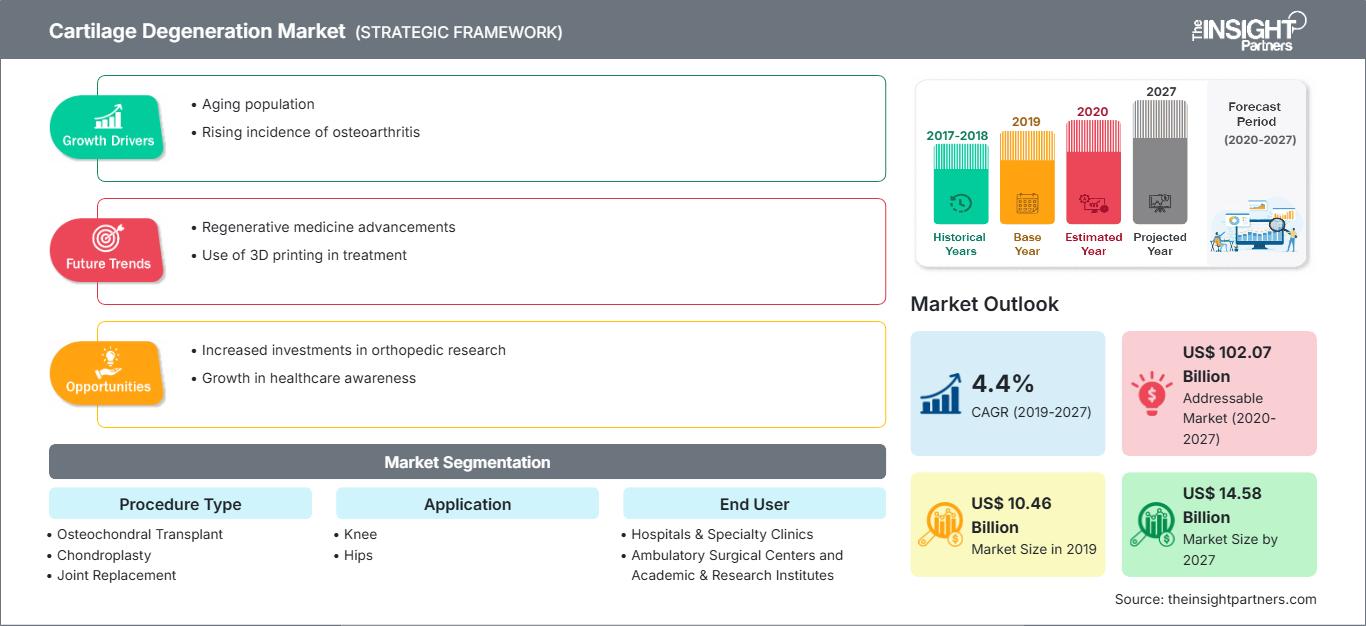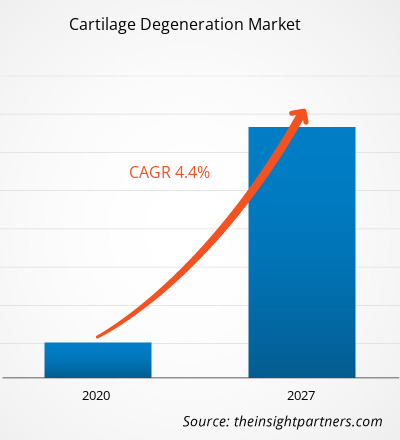Cartilage Degeneration Market Segments and Growth by 2027
Historic Data: 2017-2018 | Base Year: 2019 | Forecast Period: 2020-2027Cartilage Degeneration Market Forecast to 2027 - COVID-19 Impact and Global Analysis by Procedure Type (Osteochondral Transplant, Chondroplasty, Joint Replacement, Meniscus Transplants, Cell-based Cartilage Resurfacing, and Others); Application (Knee, Hips and Others) End User (Hospitals & Specialty Clinics, Ambulatory Surgical Centers and Academic & Research Institutes); and Geography
- Report Date : Aug 2020
- Report Code : TIPMD00002230
- Category : Life Sciences
- Status : Published
- Available Report Formats :


- No. of Pages : 169
The cartilage degeneration market is expected to reach US$ 14,580.10 million in 2027 from US$ 10,459.93 million in 2019. The market is estimated to grow with a CAGR of 4.4% from 2020-2027.
Cartilage plays an important role in smooth mechanical movements of bones and muscles. Degeneration of cartilage can lead to pain and chronic inflammation in joints. Furthermore, this damaged cartilage can potentially influence quality of the life. Continual research and development is leading to innovation of new techniques and methodologies to deal with damages cartilages. Some of these techniques comprises joint replacement, cell therapies, and chondroplasty amongst others.The global cartilage degeneration market is driven by factors such as growing number of sports injuries, and increasing prevalence of obesity. However, the high cost of cartilage repair hampers the market growth. Additionally, growing number of product approvals and developments are creating growth opportunities for the market players.
Market Insights
Increasing Prevalence of Obesity
Obesity has a considerable effect on the musculoskeletal system, resulting into degeneration of bones, cartilage, and ligaments. Moreover, the condition, along with other prominent factors, is strongly allied with the increased risk of rapid cartilage loss. The growing prevalence of obesity is likely to accelerate the incidence of cartilage degeneration, which will drive the market growth.
According to the study published by the World Health Organization (WHO) in 2020, the frequency of obesity among the worldwide population has tripled since 1975. Furthermore, according to the same study, 38 million children below 5 years of age were overweight in 2019 worldwide. This massive prevalence of obesity is likely to accelerate due to unhealthy lifestyles such as consumption of junk food, sedentary lifestyle, genetic conditions, and deprivation of mental health. For instance, according to a study published by the Centers of Disease Control and Prevention, the prevalence of obesity grew from 30.5% to 42.4% during past two decades in the US. Overweight conditions among players and athletes can lead to the increasing prevalence of sports injuries. For instance, according to a study published in the British Journal of Sports Medicine in 2015, athletes with BMI index more than 30 kg/m2 are highly susceptible generationto the sports injuries. Such association between obesity and cartilage degeneration is anticipated to drive the market growth by 2027.
Customize This Report To Suit Your Requirement
You will get customization on any report - free of charge - including parts of this report, or country-level analysis, Excel Data pack, as well as avail great offers and discounts for start-ups & universities
Cartilage Degeneration Market: Strategic Insights

-
Get Top Key Market Trends of this report.This FREE sample will include data analysis, ranging from market trends to estimates and forecasts.
Application Insights
Based on application, the cartilage degeneration market is segmented into knee, hip, and other applications. In 2019, the knee segment accounted for the highest share of the market. Growth of this segment is attributed to the increasing prevalence of knee injuries. For instance, according to study published on online newspaper, which is based on NCBI data, an estimated 1 in 4 adults suffer from chronic knee pain. Moreover, the prevalence of knee pain has witnessed massive growth of around 40.0% during past 4 decades. Furthermore, increasing awareness of benefits provided by cartilage repair is also anticipated to drive the growth of knee segment.
Procedure Type Insights
The cartilage degeneration market, by procedure type, is segmented into osteochondral transplant, chondroplasty, joint replacement, meniscus transplants, cell-based cartilage resurfacing, and other procedure types. The joint replacement segment held the largest share of the market in 2019, whereas the cell-based cartilage resurfacing segment is anticipated to register the highest CAGR in the market during the forecast period.
End User Insights
Based on end user, the cartilage degeneration market is segmented into hospitals and specialty clinics, ambulatory surgical centers and,academic & research institutes. The hospitals and specialty clinicssegment held the largest share of the market in 2019. Also, the segment is estimated to register the highest CAGR in the market during the forecast period.
Product launches and approvalsare the commonly adopted strategies by companies to expand their global footprintsand product portfoliostomeet the growing consumer demand. The cartilage degeneration marketplayers adopt the collaborationsstrategy to enlarge customer base worldwide, which also permits them to maintain their brand name globally.
Cartilage Degeneration Market Regional Insights
The regional trends and factors influencing the Cartilage Degeneration Market throughout the forecast period have been thoroughly explained by the analysts at The Insight Partners. This section also discusses Cartilage Degeneration Market segments and geography across North America, Europe, Asia Pacific, Middle East and Africa, and South and Central America.
Cartilage Degeneration Market Report Scope
| Report Attribute | Details |
|---|---|
| Market size in 2019 | US$ 10.46 Billion |
| Market Size by 2027 | US$ 14.58 Billion |
| Global CAGR (2019 - 2027) | 4.4% |
| Historical Data | 2017-2018 |
| Forecast period | 2020-2027 |
| Segments Covered |
By Procedure Type
|
| Regions and Countries Covered |
North America
|
| Market leaders and key company profiles |
|
Cartilage Degeneration Market Players Density: Understanding Its Impact on Business Dynamics
The Cartilage Degeneration Market is growing rapidly, driven by increasing end-user demand due to factors such as evolving consumer preferences, technological advancements, and greater awareness of the product's benefits. As demand rises, businesses are expanding their offerings, innovating to meet consumer needs, and capitalizing on emerging trends, which further fuels market growth.

- Get the Cartilage Degeneration Market top key players overview
Global Cartilage degeneration market– ByProcedure type
- Osteochondral Transplant
- Chondroplasty
- Joint Replacement
- Meniscus Transplants
- Cell-based Cartilage Resurfacing
- Others Procedures
Global Cartilage degeneration market– By Application
- Knee
- Hip
- Other Applications
Global Cartilage degeneration market– By End User
- Hospitals and Specialty
- Clinics, Ambulatory Surgical Centres
- Academic and Research Institutes
Cartilage degeneration market– By Geography
-
North America
- US
- Canada
- Mexico
-
Europe
- France
- Germany
- Italy
- UK
- Spain
- Rest of Europe
-
Asia Pacific (APAC)
- China
- India
- South Korea
- Japan
- Australia
- Rest of Asia Pacific
-
Middle East and Africa (MEA)
- South Africa
- Saudi Arabia
- UAE
- Rest of Middle East and Africa
-
South and Central America
- Brazil
- Argentina
- Rest of South America
Company Profiles
- Zimmer Biomet
- CartiHeal Inc.
- Vericel Corporation
- Depuy Synthes
- Anika Therapeutics, Inc.
- Conmed Corporation
- Arthrex,Inc.
- B. Braun Melsungen AG
- Stryker
- Smith and Nephew Plc..
Frequently Asked Questions
Which end-user held the largest share in the cartilage degeneration market?
What is the growth rate of cartilage degeneration market?
Which region has highest growth rate in cartilage degeneration market?
What are the driving factors for the cartilage degeneration market across the globe?
Who are the key players in the cartilage degeneration market?
Mrinal is a seasoned research analyst with over 8 years of experience in Life Sciences Market Intelligence and Consulting. With a strategic mindset and unwavering commitment to excellence, she has built deep expertise in pharmaceutical forecasting, market opportunity assessment, and developing industry benchmarks. Her work is anchored in delivering actionable insights that empower clients to make informed strategic decisions.
Mrinal’s core strength lies in translating complex quantitative datasets into meaningful business intelligence. Her analytical acumen is instrumental in shaping go-to-market (GTM) strategies and uncovering growth opportunities across the pharmaceutical and medical device sectors. As a trusted consultant, she consistently focuses on streamlining workflow processes and establishing best practices, thereby driving innovation and operational efficiency for her clients.
- Historical Analysis (2 Years), Base Year, Forecast (7 Years) with CAGR
- PEST and SWOT Analysis
- Market Size Value / Volume - Global, Regional, Country
- Industry and Competitive Landscape
- Excel Dataset
Recent Reports
Testimonials
The Insight Partners' SCADA System Market report is comprehensive, with valuable insights on current trends and future forecasts. The team was highly professional, responsive, and supportive throughout. We are very satisfied and highly recommend their services.
RAN KEDEM Partner, Reali Technologies LTDsI requested a report on a very specific software market and the team produced the report in a few days. The information was very relevant and well presented. I then requested some changes and additions to the report. The team was again very responsive and I got the final report in less than a week.
JEAN-HERVE JENN Chairman, Future AnalyticaWe worked with The Insight Partners for an important market study and forecast. They gave us clear insights into opportunities and risks, which helped shape our plans. Their research was easy to use and based on solid data. It helped us make smart, confident decisions. We highly recommend them.
PIYUSH NAGPAL Sr. Vice President, High Beam GlobalThe Insight Partners delivered insightful, well-structured market research with strong domain expertise. Their team was professional and responsive throughout. The user-friendly website made accessing industry reports seamless. We highly recommend them for reliable, high-quality research services
YUKIHIKO ADACHI CEO, Deep Blue, LLC.This is the first time I have purchased a market report from The Insight Partners.While I was unsure at first, I visited their web site and felt more comfortable to take the risk and purchase a market report.I am completely satisfied with the quality of the report and customer service. I had several questions and comments with the initial report, but after a couple of dialogs over email with their analyst I believe I have a report that I can use as input to our strategic planning process.Thank you so much for taking the extra time and making this a positive experience.I will definitely recommend your service to others and you will be my first call when we need further market data.
JOHN SUZUKI President and Chief Executive Officer, Board Director, BK TechnologiesI wish to appreciate your support and the professionalism you displayed in the course of attending to my request for information regarding to infectious disease IVD market in Nigeria. I appreciate your patience, your guidance, and the fact that you were willing to offer a discount, which eventually made it possible for us to close a deal. I look forward to engaging The Insight Partners in the future, all thanks to the impression you have created in me as a result of this first encounter.
DR CHIJIOKE ONYIA MANAGING DIRECTOR, PineCrest Healthcare Ltd.Reason to Buy
- Informed Decision-Making
- Understanding Market Dynamics
- Competitive Analysis
- Identifying Emerging Markets
- Customer Insights
- Market Forecasts
- Risk Mitigation
- Boosting Operational Efficiency
- Strategic Planning
- Investment Justification
- Tracking Industry Innovations
- Aligning with Regulatory Trends




















 Get Free Sample For
Get Free Sample For